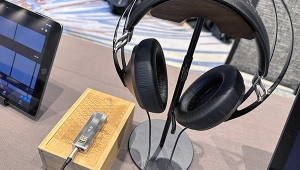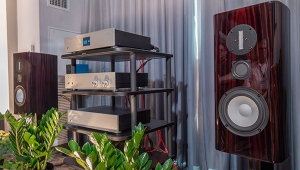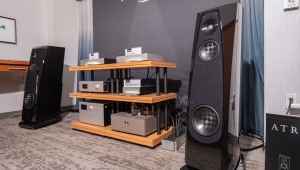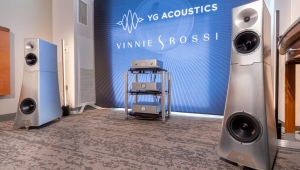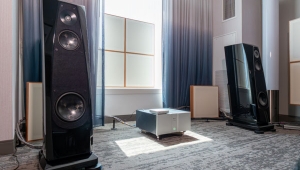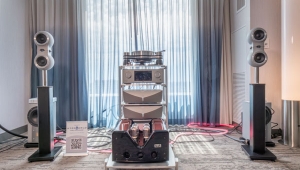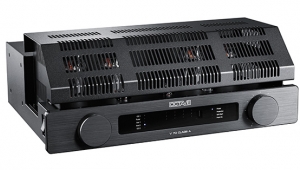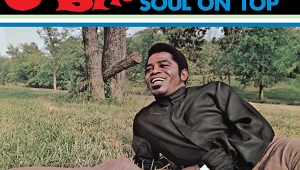| Columns Retired Columns & Blogs |
The Outstanding Bose Quiet Comfort 35 Wireless Noise Canceling Headphone Page 2
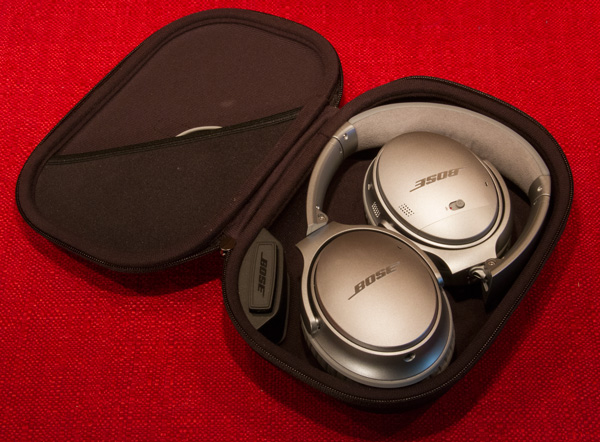
Quality of Noise Cancelation
Historically, noise cancelers have been among the worst sound quality headphones. Briefly, a signal is generated in the headphones that is a mirror image of the acoustic signal from surrounding noise. That inverted signal is added to the electrical signal from you player. Ideally, it cancels out the surrounding noise so you only hear the music. Sounds easy, right?
Well, not so fast: The actual acoustic signal you want to cancel is not the external noise itself, but rather that part of it that manages to get into the earcup. So noise cancelers have little microphones inside the cup to hear what's going on. Well...there's music in there as well. How does the headphone know the difference between the music inside the cup, and the stuff from the outside that manages to get in there?
The answer is (sort of) that there are microphones on the outside of the headphone as well that listen to the ambient acoustic signal so it can recognize it inside the cups (sort of). This oversimplification borders on untruthful—noise canceling is very, very, very complicated to pull off...especially if you want the music to sound good in the end as well.
Early on, most noise canceling circuits were analog and tuned for the particular headphone. These circuit analogs are mear approximations of the actual acoustic situation going on in real life. The result was disorienting weird. People used to often say, "I turned the noise canceler on and about fell over...they almost make me loose my balance." Five years ago, all noise cancelers sounded like crap. Go listen to the old Bose QC3 and you'll see what I mean...and that was one of the best at the time.
For years now, Bose has been hammering away at this noise canceling technology. Now there are numerous internal and external microphones, and a seriously complex noise canceling algorithm implemented by a digital signal processing engine doing one hell of a lot of math to get it right. From some brief comments from another manufacturer, Bose has killed it with their technological advancement, and has, essentially (and for the moment), patented themselves into a commanding lead with noise cancelers.
As evidence of their forward march, take a look at the isolation plots from the QC15, QC25, and QC35. Broadband isolation measurements are -26dBr; -27dBr; and -28dBr respectively. It doesn't sound like a lot, but every little bit counts. More importantly, and we'll get to it in more detail in a moment, frequency response plots show Bose also inching their way towards a better tonal profile.
There's another important aspect that doesn't (usually) show up in the measurements. Noise cancelers are highly tuned to the acoustics in and around the headphones. With many, if you cup your hands around the outside of the ear capsules, you can alter the local acoustic situation around the headphones and bring it outside the normal operating conditions of the noise canceling system. Many noise cancelers will begin to go unstable and make weird feedback-like squeals or chuffing.
Under normal conditions, they may work fine, but if you wear the headphones in bed, the pillow may alter the acoustic around the headphone and act weird. Or it can happen if you're wearing a jacket with a hood. Sometimes a hoodie just bunched up around your neck will set one off.
With the quiet comfort 35, I tried everything I could to get them to go unstable...to little avail. The most sensitive way I've found to listen for these issues is to play pink noise and listen for changes as I mess with the headphones. The only thing I found as I cupped or placed my hands on or around the ear capsules was a modest momentary change to tonality, especially in the bass. The really interesting thing is the change would be momentary as the DSP caught up with the conditions. After placing my hands somewhere I'd hear the tonal change and then it would go back to normal even though my hand was still in place. Also, I could hear a similar effect if I laid on a pillow and rolled my head from side to side.
Bottom line: Not only is the the most effective noise canceler I've experienced to date, it's also the most acoustically stable. This thing works great!
Sound Quality
I tested three listening modes for the QC35: passive on the wire; active on the wire; and active wirelessly.
Passive - In this mode, power is off and the headphones are acting like a normal pair of headphones. Often with DSP headphones (Parrot Zik, for example) designers don't worry about the sound in passive mode; they're mostly looking for a situation where the driver is well behaved regardless of tonal character. Ten they fix the EQ in DSP to make the headphones match their target response. The problem here is that when you run out of battery power and listen on the wire, the sound sucks.
In the case of the QC35, passive sound performance is decent, gross tonal balance is good. But, bass is a little overemphatic and loose, and the midrange has a boxy coloration. Treble is generally good but a bit splashy, they don't project an image of any special note. I'd put them on par with a good, but not great, $200 over-ear, sealed headphone.
On the other hand, comparing it directly with other experiences listening to noise canceling headphones in passive mode, I'd say the QC35 equals or bests anything I've heard to date.
Active Wired - Bass is wicked tight and well extended. It's well in-line with the Harman target response; elevated about 5dB with a long gentle upward slope. I had no sense of the bass intruding on the mid-range; transition to the mid-range is excellent.
Mid-range is coherent and smooth; little, if any, gross coloration. Upper-midrange is a little laid back causing vocals to sound just a bit veiled and lacking presence.
Treble is where the shit hits the fan. I've used this word before and I hear this effect with some regularity: The treble sounds sort of like it's coming from a crinkled cellophane speaker. Sibilant sounds take on an additional artificial character. I don't want to overstate this problem, but I don't want to understate it either. If I listen to a bunch of energetic and poorly recorded music I end up with listening fatigue within a half hour and have to remove the cans. With good recordings this problem is significantly reduced.
It's important to note that in actual use in loud environments, the listening experience had with the QC35 will still probably be better than that of a similarly priced passive, sealed headphone. The noise reduction and attendant ability to listen at a lower level may actually provide lower listening fatigue with the QC35.
Active Wireless - When listening in Bluetooth wireless mode the QC35 has largely the same character as when used in active wired mode. There is one significant difference however, Bose calls it: Volume Optimized EQ. As you raise and lower the volume at the headset the headphone changes EQ along the lines of the Fletcher-Muson equal loudness contour curves—or Bose' version of it, but same idea. When I raise my phone to full volume and lower the volume on the headset, I can clearly hear the bass has been emphasized at low volume. When I leave the QC35 volume high and lower the volume on the phone, I do not hear this bass emphasis. I felt this tuning worked quite well, it gave the music a nice little thump when I was listening quietly. Should you purchase a pair and use it in Bluetooth mode, raise the phone volume to one step below the top and then use the headset controls to adjust listening levels.
Summary
I opened this review by saying I found this headphone value packed. I see it that way because I know how much very complex technology it takes to pull off the noise canceling trick and still sound decent. $350 isn't cheap, but the Quiet Comfort 35 delivers world class noise canceling and best-in-class sonic performance.
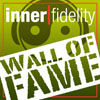 Add to that outstanding build quality; terrific comfort; convenient folding features; a dandy carry case; good performance when the battery dies; and...well...you're getting one hell of a value. If you're a traveler or someone who needs a good noise canceling headphone, bite the bullet, cry once, and get the Bose Quiet Comfort 35. A killer noise canceler...yeah, these are going right up on the "Wall of Fame"
Add to that outstanding build quality; terrific comfort; convenient folding features; a dandy carry case; good performance when the battery dies; and...well...you're getting one hell of a value. If you're a traveler or someone who needs a good noise canceling headphone, bite the bullet, cry once, and get the Bose Quiet Comfort 35. A killer noise canceler...yeah, these are going right up on the "Wall of Fame"
If only they'd have put a one-button remote on the cable...*le sigh*.
Video
Click here to view on YouTube.
Resources
Bose home page and Quiet Comfort 35 product page.
Head-Fi discussion threads here and here.
- Log in or register to post comments
























